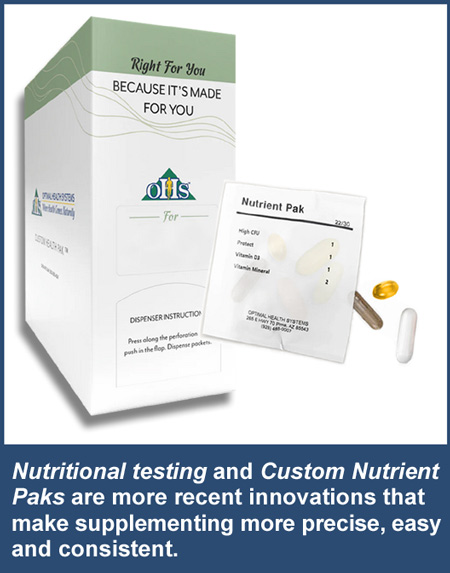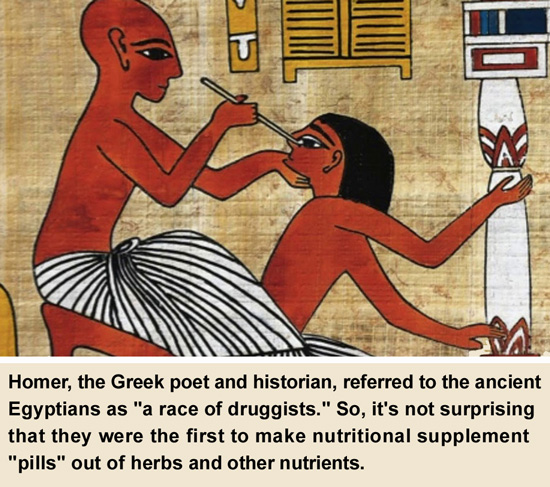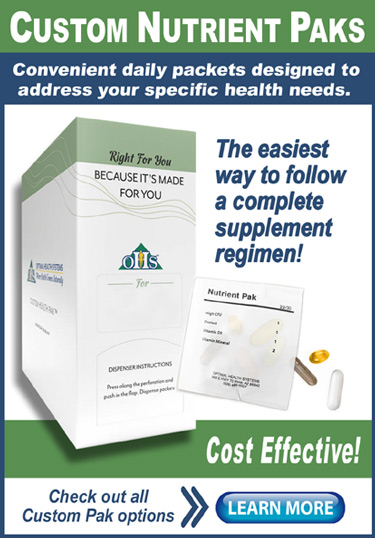If you think nutritional supplements are something new, think again. Supplements in a a pill or tablet form go back about 3,500 years, and liquids and powders even further.
Today new technologies—such as nutritional testing and Custom Nutrient Paks—take supplementing to a new level of efficiency and consistency. But before we talk about those, let’s take a look back at how we got here.
Historical rewind
According to George Griffenhagen, an author and retired pharmacist who spent decades studying pharmacy and supplementing history, “pills” date back to roughly 1500 BC. References for pills appear in Egyptian papyruses that are filled with medical remedies.
The instructions included pills made from bread dough, honey and grease.
Similar examples also existed in China over 2,000 years ago—such as small herb balls, held together by hardened honey, for treating female issues.
Supplementation existed before that—as documented on Assyrian clay tablets—but they were recipes for liquid preparations.
In ancient Greece, the round balls or other shapes were called katapotia (meaning “something to be swallowed”).
Following the Greeks, the Roman scholar Pliny the Elder, who lived from 23-79 AD, coined the word “pilula”—the origin of the word pill.
Starting in medieval times, people came up with a new technology of their own—they would coat their pills with slimy plant substances and other materials so they’d go down more easily or taste less bitter.
Patents for pills
Medicines in pill form grew in popularity in 17th century England and thereafter. Pill manufacturers were even granted special patent rights from the king for their top-secret formulas.
Most of these healing pills would be more akin to today’s nutritional supplements—with mostly herbs and other organic constituents—since pharmaceutical manufacturing as we know it today had not developed yet. (Though the people of England and Europe were certainly no strangers to opioids at this time.)
According to 2002 research published in the Los Angeles Times, the old-fashioned “roll-and-cut” kinds of pills had a drawback: Their preparation required moisture—and health professionals were learning that this moisture could inactivate the beneficial ingredients in them.
Because of this the 1800s saw a whole slew of innovations. First there was sugar-coating and gelatin-coating of pills. This not only made them taste better, but also protected the ingredients from the environment.
Then came the invention of the “compressed tablet.” Instead of powder being loosely held together by any kind of sticky agent, powder was put in a tube and compressed solidly—and more permanently—with high pressure.
The next jump in technology was also in the 1800s—the invention of gelatin capsules. Though not as sophisticated as today’s gelatin capsules, early capsules at least offered a way for medicines and supplements to be kept air-tight and more efficacious.
The age of vitamins
All the formally-recognized vitamins were discovered between 1913 and 1948. In the middle of that period—in 1935—commercially produced tablets of yeast-extract vitamin B complex and semi-synthetic vitamin C became available.
The term “vitamin” was derived from “vitamine”, a portmanteau coined in 1912 by the biochemist Casimir Funk while working at the Lister Institute of Preventive Medicine (now part of University of London).
Funk created the name from “vital” and “amine” because it appeared that these organic micronutrient food factors were required for life. This was based largely on the discovery that thiamine (Vatamin B1) prevented beriberi. So, “vital” represented the essential nature, while “amines” stood for the chemical amines that were present.
However, while the theory held true in the case of thiamine, it was later determined that Vitamin C and other such micronutrients were not amines—so the word was shortened to “vitamin” in English.
As the popularity of vitamin supplements soared in subsequent decades “vitamins” became almost synonomous for any kind of nutritional supplement. A person taking a mix of herbs, minerals, vitamins and other nutrients might just say, “I need to take my vitamins” as a general term for all the supplements they were taking.
This trend finally died out as literally hundreds of beneficial nutrients were discovered (or rediscovered), researched and marketed in the 21st Century.
Custom Paks — the latest innovation
Perhaps the best iteration in supplementing history is the invention of customized supplementing with Custom Nutrient Paks.
Custom Nutrient Paks make supplementing more consistent—and thereby more effective—by putting the nutrients a person needs most into convenient daily packets.
With Custom Nutrient Paks you don’t have to juggle a shelf full of different supplement bottles. Each Custom Nutrient Pak comes with all the desired nutrients presorted into daily doses.
If you need to support a specific health need—such as pain, energy or allergies—you can select from a wide choice of “semi” custom paks that already have pre-selected nutrients to address those needs. Or, you can choose to design your own fully-customized custom pak based on the results of nutritional testing.
Custom Nutrient Paks not only provide convenience, but also encourage more consistent supplement taking. If a health professional suggests certain nutrients, health consumers are more likely to adhere to a program if all they have to do is pull out a pre-sorted supplement packet once or twice a day.
Best of all, Custom Nutrient Paks are cost-effective! With all your supplements packed in a single box, the cost is far more economical than buying five or six bottles of different products.
Learn more about all our Custom Nutrient Pak options by clicking the banner ad on this page.
Not sure about what nutritional supplements you need? Optimal Health Systems’ Nutrients Rx Lab Work can help.
– – –
Sources: JustAPedia-vitamin, LATimes.com, FactsAndDetails.com.



